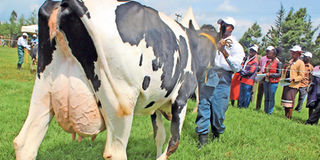What to go for when buying bull semen

Farmers taken through bull selection and calf-rearing at Plateau Country Farm in Uasin Gishu last week during a field day organised by Bles Dairies East Africa Ltd. The breeding objective of every farmer is to ensure the offspring is better than the mother. PHOTO | STANLEY KIMUGE | NMG
What you need to know:
- A dairy farmer must select his bull semen from a pool of bulls with proven transferability of protection against mastitis.
- The production must be in terms of volume of milk and milk components like protein and fats.
- The beauty of a cow is in the genes and if a farmer is breeding heifers for sale and for agricultural shows, select your bull semen from a pool of beautiful bulls to inherit good conformation.
- If a dairy farmer has a cow whose production is low, the first bull semen selection criteria should be production trait.
The big question often asked by dairy farmers is that what is the role of bull semen in cattle improvement. Bull semen is the pathway to profitable dairy business, therefore, must be able to transfer the following traits to a dairy herd.
Longevity
This is the period your high-yielding cow stays on the farm producing. It is important for the financial performance of the herd.
High longevity means a low culling rate, high milk production and low vet costs. The higher the number of lactations per cow, the higher the life time milk production and the more profitable the cow is.
Health and fertility
Udder health is a major challenge affecting the dairy enterprise. It leads to huge losses arising from reduced production, high vet costs and is a major cause of high culling rates.
A dairy farmer must select his bull semen from a pool of bulls with proven transferability of protection against mastitis.
Often linked to this trait is fertility. Kenyan dairy cows have long calving intervals. Ideally, a cow should produce a calf once a year but the average calving interval is about 600 days.
The problem, more often, is the inability to conceive usually preceded by silent heat and sometimes accompanied by pregnancy loss or abortion.
These problems can be avoided by breeding for fertility. The power is in the genes hence a farmer must select bull semen that will impart this power to the daughters of his cows and heifers
Production
Overall milk production determines a herd’s income. If a farmer is breeding for profits, he must select from the leading cow families in terms of milk production and the willingness to produce.
The production must be in terms of volume of milk and milk components like protein and fats
Conformation
Bull semen will transfer features that contribute to stature of the future cow. The feet and legs must be “dairy” to carry the weight of the animal and aid in locomotion, especially grazing animals.
Conformation traits determine the longevity of the cow and how durable they are and avoid issues of lameness and retained placenta as well they are a factor of milk production.
The beauty of a cow is in the genes and if a farmer is breeding heifers for sale and for agricultural shows, select your bull semen from a pool of beautiful bulls to inherit good conformation.
Reliability
A farmer will select the right bull semen from a bull catalogue. The information contained in a catalogue must be derived from large number of tests done on the semen and proven to be repeatable over and over using a large population of animals.
Genome trials where gene mapping of useful traits is done on young bulls before they even reach semen production age (puberty) is also used to create bull catalogues.
Selected bull semen must have high reliability for a dairy farmer to trust and use.
If a dairy farmer has a cow whose production is low, the first bull semen selection criteria should be production trait.
Therefore, select semen from a bull with high production. If the same cow has problems with feet or hooves, the farmer should select to improve both production, feet and legs. It is important that the farmer uses semen from renowned suppliers.
The breeding objective of every farmer is to ensure the offspring is better than the mother.
Success in breeding is dependent upon other factors including feeding the cows well with a balanced diet that has energy, protein, vitamins, mineral salts like Maclik Super (for lactating cows), Maclik Plus for heifers and clean water.
Detection of heat and proper timing of insemination is key in ensuring conception occurs. The signs to look out for are bellowing, mounting, standing to be mounted, clear vulval discharge and vulval swelling.
Artificial insemination should be done when the cow is standing to be mounted usually 12 hours since the heat signs are first noticed.
Proper record-keeping is important to track the heat, pregnancy history and to trace the pedigree development for each cow family.
Article written by dairy specialists at Cooper K Brands




